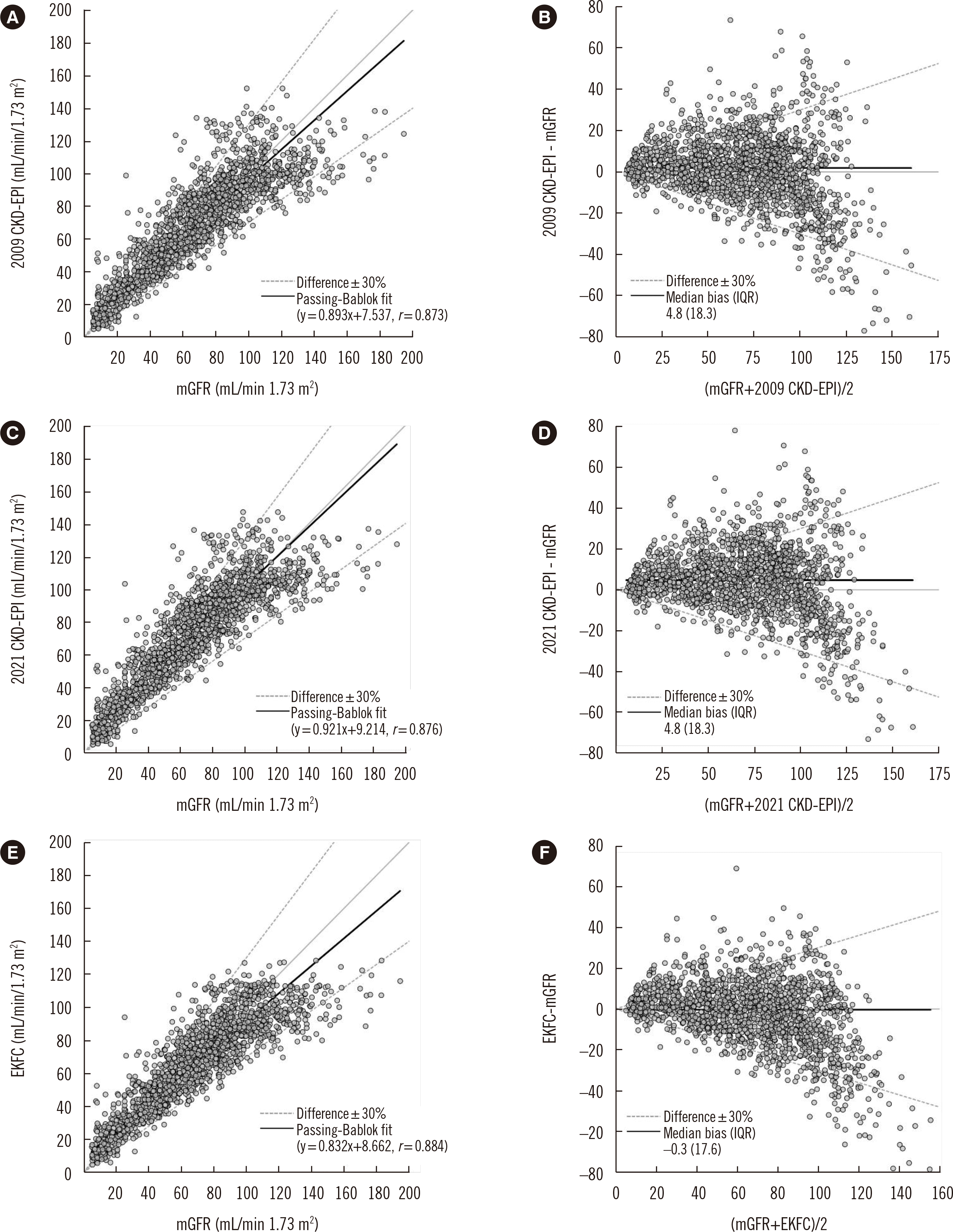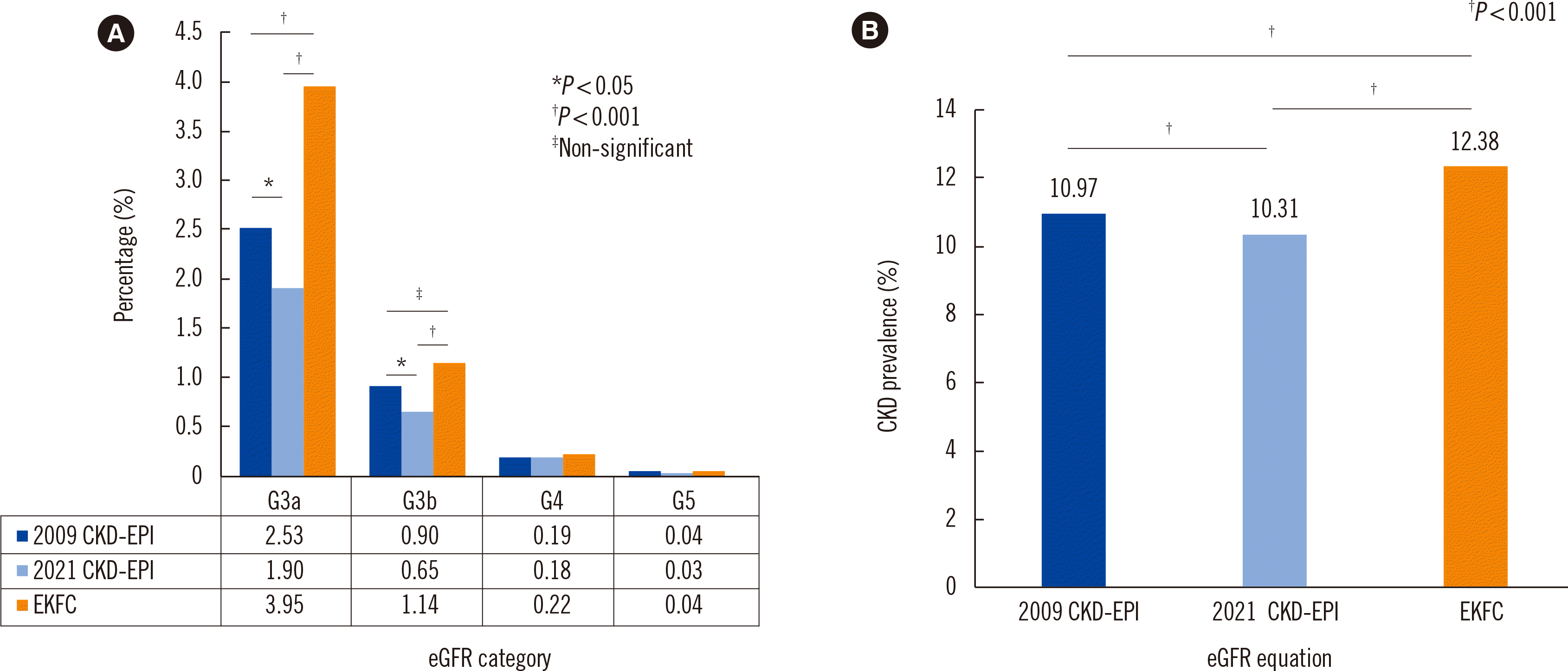1. Inker LA, Eneanya ND, Coresh J, Tighiouart H, Wang D, Sang Y, et al. 2021; New creatinine- and cystatin C-based equations to estimate GFR without race. N Engl J Med. 385:1737–49. DOI:
10.1056/NEJMoa2102953. PMID:
34554658. PMCID:
PMC8822996.

2. Stevens LA, Coresh J, Greene T, Levey AS. 2006; Assessing kidney function-measured and estimated glomerular filtration rate. N Engl J Med. 354:2473–83. DOI:
10.1056/NEJMra054415. PMID:
16760447.

3. Levey AS, Coresh J, Tighiouart H, Greene T, Inker LA. 2019; Strengths and limitations of estimated and measured GFR. Nat Rev Nephrol. 15:784. DOI:
10.1038/s41581-019-0213-9. PMID:
31578495.

4. Nichols GA, Ustyugova A, Déruaz-Luyet A, O'Keeffe-Rosetti M, Brodovicz KG. 2020; Health care costs by type of expenditure across eGFR stages among patients with and without diabetes, cardiovascular disease, and heart failure. J Am Soc Nephrol. 31:1594–601. DOI:
10.1681/ASN.2019121308. PMID:
32487562. PMCID:
PMC7350988.

5. GBD Chronic Kidney Disease Collaboration. Global, regional, and national burden of chronic kidney disease, 1990-2017: a systematic analysis for the Global Burden of Disease Study 2017. Lancet. 2020; 395:709–33.
6. Miller WG, Jones GRD. 2018; Estimated glomerular filtration rate; laboratory implementation and current global status. Adv Chronic Kidney Dis. 25:7–13. DOI:
10.1053/j.ackd.2017.09.013. PMID:
29499890.

7. Miller WG, Kaufman HW, Levey AS, Straseski JA, Wilhelms KW, Yu HE, et al. 2022; National Kidney Foundation Laboratory Engagement Working Group recommendations for implementing the CKD-EPI 2021 race-free equations for estimated glomerular filtration rate: practical guidance for clinical laboratories. Clin Chem. 68:511–20. DOI:
10.1093/clinchem/hvab278. PMID:
34918062.

8. Kim SK, Jeong TD, Park S, Lee YW, Min WK. 2019; Current status of estimated glomerular filtration rate reporting in Korea. J Lab Med Qual Assur. 41:201–6. DOI:
10.15263/jlmqa.2019.41.4.201.

9. Costa NR, Carvalho ARM, Pinto CMA, Andriolo A, Guerra IC. 2017; Laboratory diagnosis of chronic kidney disease in adults: an overview of hospitals inserted in the Portuguese National Health System. J Bras Patol Med Lab. 53:388–96. DOI:
10.5935/1676-2444.20170062.
10. Madero M, Sarnak MJ. 2011; Creatinine-based formulae for estimating glomerular filtration rate: is it time to change to chronic kidney disease epidemiology collaboration equation? Curr Opin Nephrol Hypertens. 20:622–30. DOI:
10.1097/MNH.0b013e32834ba210. PMID:
21941179.
11. Levey AS, Bosch JP, Lewis JB, Greene T, Rogers N, Roth D. 1999; A more accurate method to estimate glomerular filtration rate from serum creatinine: a new prediction equation. Modification of Diet in Renal Disease Study Group. Ann Intern Med. 130:461–70. DOI:
10.7326/0003-4819-130-6-199903160-00002. PMID:
10075613.

13. Delgado C, Baweja M, Burrows NR, Crews DC, Eneanya ND, Gadegbeku CA, et al. 2021; Reassessing the inclusion of race in diagnosing kidney diseases: an interim report from the NKF-ASN task force. J Am Soc Nephrol. 32:1305–17. DOI:
10.1681/ASN.2021010039. PMID:
33837122. PMCID:
PMC8259639.

14. Cerdeña JP, Plaisime MV, Tsai J. 2020; From race-based to race-conscious medicine: how anti-racist uprisings call us to act. Lancet. 396:1125–8. DOI:
10.1016/S0140-6736(20)32076-6. PMID:
33038972.

15. Vyas DA, Eisenstein LG, Jones DS. 2020; Hidden in plain sight-reconsidering the use of race correction in clinical algorithms. N Engl J Med. 383:874–82. DOI:
10.1056/NEJMms2004740. PMID:
32853499.

16. Oni-Orisan A, Mavura Y, Banda Y, Thornton TA, Sebro R. 2021; Embracing genetic diversity to improve black health. N Engl J Med. 384:1163–7. DOI:
10.1056/NEJMms2031080. PMID:
33567186.

17. Ioannidis JPA, Powe NR, Yancy C. 2021; Recalibrating the use of race in medical research. JAMA. 325:623–4. DOI:
10.1001/jama.2021.0003. PMID:
33492329.

18. Pottel H, Björk Bjork J, Courbebaisse M, Couzi L, Ebert N, Eriksen BO, et al. 2021; Development and validation of a modified full age spectrum creatinine-based equation to estimate glomerular filtration rate: a cross-sectional analysis of pooled data. Ann Intern Med. 174:183–91. DOI:
10.7326/M20-4366. PMID:
33166224.

19. Pottel H, Hoste L, Dubourg L, Ebert N, Schaeffner E, Eriksen BO, et al. 2016; An estimated glomerular filtration rate equation for the full age spectrum. Nephrol Dial Transplant. 31:798–806. DOI:
10.1093/ndt/gfv454. PMID:
26932693. PMCID:
PMC4848755.

20. KDIGO 2012 clinical practice guideline for the evaluation and management of chronic kidney disease. Kidney Int. 2013; 3:19–62.
21. Meeusen JW, Kasozi RN, Larson TS, Lieske JC. 2022; Clinical impact of the refit CKD-EPI 2021 creatinine-based eGFR equation. Clin Chem. 68:534–9. DOI:
10.1093/clinchem/hvab282. PMID:
35038721.

22. Levey AS, Tighiouart H, Inker LA. 2021; Improving glomerular filtration rate estimation-across the age and diversity spectrum. Ann Intern Med. 174:265–7. DOI:
10.7326/M20-6983. PMID:
33166223.

23. Fleming JS, Zivanovic MA, Blake GM, Burniston M, Cosgriff PS. British Nuclear Medicine Society. 2004; Guidelines for the measurement of glomerular filtration rate using plasma sampling. Nucl Med Commun. 25:759–69. DOI:
10.1097/01.mnm.0000136715.71820.4a. PMID:
15266169.

25. National Kidney Foundation. K/DOQI clinical practice guidelines for chronic kidney disease: evaluation, classification, and stratification. Am J Kidney Dis. 2002; 39(2 Suppl 1):S1–266.
26. Marzinke MA, Greene DN, Bossuyt PM, Chambliss AB, Cirrincione LR, McCudden CR, et al. 2022; Limited evidence for use of a black race modifier in eGFR calculations: a systematic review. Clin Chem. 68:521–33. DOI:
10.1093/clinchem/hvab279. PMID:
34927677.

27. Delgado C, Baweja M, Crews DC, Eneanya ND, Gadegbeku CA, Inker LA, et al. 2022; A unifying approach for GFR estimation: recommendations of the NKF-ASN task force on reassessing the inclusion of race in diagnosing kidney disease. Am J Kidney Dis. 79:268–88.e1. DOI:
10.1053/j.ajkd.2021.08.003. PMID:
34563581.

28. Jeong TD, Cho EJ, Lee K, Lee W, Yun YM, Chun S, et al. 2021; Recent trends in creatinine assays in Korea: long-term accuracy-based proficiency testing survey data by the Korean Association of External Quality Assessment Service (2011-2019). Ann Lab Med. 41:372–9. DOI:
10.3343/alm.2021.41.4.372. PMID:
33536355. PMCID:
PMC7884186.

29. Arora P, Rajagopalan S, Patel N, Nainani N, Venuto RC, Lohr JW. 2012; The MDRD equation underestimates the prevalence of CKD among blacks and overestimates the prevalence of CKD among whites compared to the CKD-EPI equation: a retrospective cohort study. BMC Nephrol. 13:4. DOI:
10.1186/1471-2369-13-4. PMID:
22264268. PMCID:
PMC3398292.

30. Delanaye P, Cavalier E, Mariat C, Maillard N, Krzesinski JM. 2010; MDRD or CKD-EPI study equations for estimating prevalence of stage 3 CKD in epidemiological studies: which difference? Is this difference relevant? BMC Nephrol. 11:8. DOI:
10.1186/1471-2369-11-8. PMID:
20515483. PMCID:
PMC2891733.







 PDF
PDF Citation
Citation Print
Print



 XML Download
XML Download